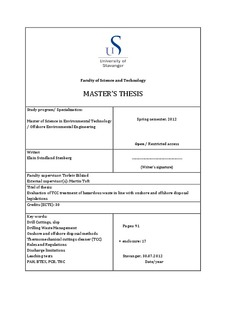| dc.description.abstract | The significance of a proper Drilling Waste Management has increased in the Petroleum Industry throughout the years. Development of a sustainable Drilling Waste Management is often associated with complying with zero hazardous discharge in drilling operations as well as prevalent rules and regulations. In this process more focus has been directed towards finding and developing a best available technique, which should include a proper handling, processing, transportation and disposition of the material without the potential for causing adverse affects to the environment.
Several assessments have previously been conducted to determine if the treatment method Thermomechanical cuttings cleaner (TCC) could potentially be considered a best available technique for offshore treatment of drill cuttings. The results from these studies have indicated several benefits of implementing the TCC method offshore. However, there is still remaining work that needs to be done before this discussion is complete.
The objective of this research was to conduct a pre-study of untreated and treated cuttings, and water fraction from TCC treated cuttings to set a possible foundation for the upcoming OLF study on TCC for offshore treatment of drilling waste. This also included an assessment of the TCC method as an offshore treatment method against current rules and regulations in Norway, and an evaluation of potential discharge of water fraction from TCC.
Implementation of an offshore treatment method of drilling waste has not yet been successful in Norway. Thus, most of the produced drilling waste is sent onshore for treatment and subsequently disposed at landfills. Due to this, the objective of this research also included an evaluation of the solid fraction from TCC treatment against requirements for the three different categories for landfill in Norway. In addition the eligibility of direct discharge of water fraction from TCC treatment was evaluated against local onshore discharge requirements.
In order to characterize the solids and water fraction from TCC treatment, analysis was conducted on both untreated and treated drill cuttings and heavy slop as well as the recovered water phases. Results from the untreated and treated solids indicated a high percentage removal of test parameters such as hydrocarbons, PAH and BTEX during TCC processing. However, the removal efficiency was relatively low for heavy metals. Observations from the recovered water phases indicated that most of the BTEX evaporates together with the water, while only some of the PAH will follow the water phase.
Discharge limit set for processed water in Norwegian Continental Shelf (NCS) is 30 mg oil per liter of water as a weighted average for one calendar month. The detected oil in water concentration in retrieved water phase after TCC treatment was 14.8 mg/l, well below the requirement. According to the prevalent discharge limit, discharge of the recovered water phase could therefore be a potential outcome if the TCC unit were to be implemented offshore.
The oil-on-cuttings concentration in treated drill cuttings and slop was also below the discharge requirements set for the NCS. Samples of treated drill cuttings constitute of 3.3 and 2.8 g oil per kg of dry material in sample 2 and 3, respectively. While treated slop consist of 2.1 and 2.0 g of oil per kg of dry material in sample 7 and 8, respectively. This upholds the requirements of 10 grams of oil per kg of dry material.
Even further studies are required in order to assess the possibility of direct discharge of the treated drill cuttings offshore. This could include a further assessment of the chemical composition of treated drilling waste, chemical fate during TCC processing, particle fate and potential effect to the environment if discharged.
Comparing limit values for organic parameters in inert waste against treated drill cuttings, showed too high concentrations of TOC and mineral oil. Thus, it was concluded that the drill cuttings was unsuitable for disposal at inert landfills. However, the treated waste upholds the leaching limit values and organic parameters for disposal at hazardous waste landfills.
The retrieved water phases after TCC processing indicated a TOC concentration above the discharge limit of 1000 mg/l set for Halliburton Mongstad. In addition the oil-in-water and mercury concentration was too high for recovered water after treatment of heavy slop and drill cuttings, respectively. Due to this it was concluded that the recovered water is not clean enough to be directly discharged onshore after TCC treatment. It was recommended to implement additional treatment in order to decrease the TOC and oil-in-water concentrations below the discharge limits set for Halliburton Mongstad.
Weaknesses in the experimental method used in this work include uncertainties affiliated with collection of representative samples. This is due to difficulties associated with estimation of how long processing time a batch of untreated heavy slop or drill cuttings requires, from the time it enters the TCC unit until it leaves the unit as a treated powder. In addition there is the possibility of retrieving samples which are not homogenous, rendering inconsistencies in the results. Since no parallel tests were performed of the analysis’s it is difficult to compare and evaluate if the values retrieved are correct or too influenced by uncertainties. Thus, it was suggested to perform parallel tests in order to verify the results. | no_NO |
